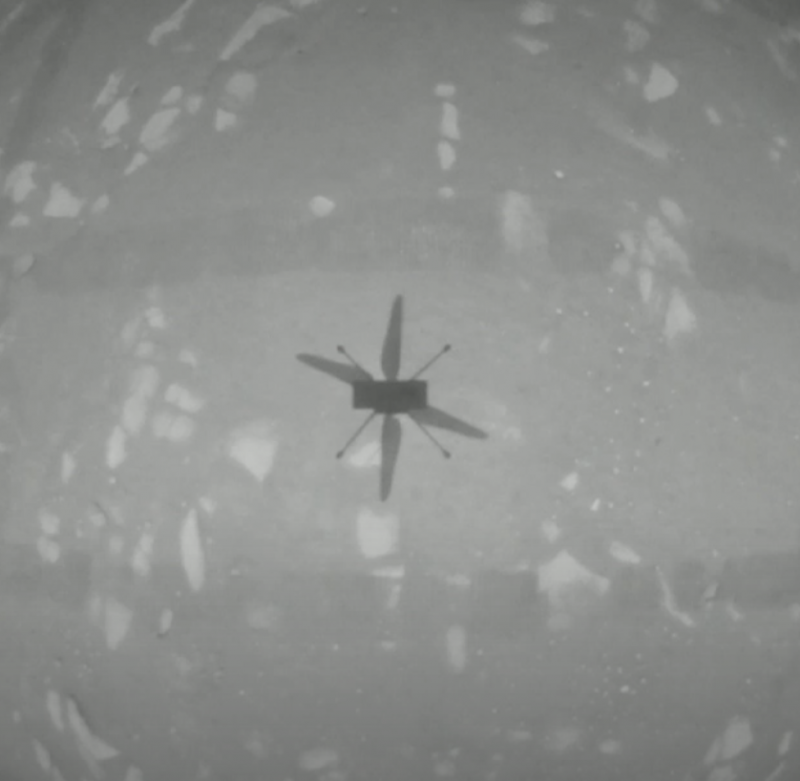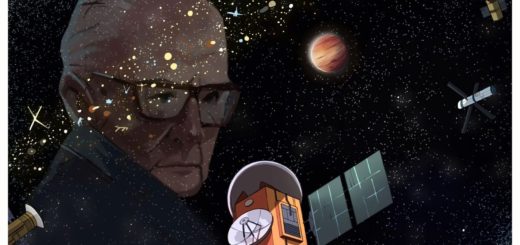It Flew! Mars Helicopter Takes To The Air

UPDATE APRIL 24, 2021: The Mars helicopter Ingenuity has successfully flown twice now, and NASA is prepping for a third flight. For an update, visit this NASA page.
NASA’s Mars helicopter Ingenuity successfully flew for the first time in the thin air above the red planet on April 19, 2021. The team at NASA’s Jet Propulsion Laboratory (JPL) in Pasadena, California, broke into cheers as flight controllers announced the success of this first demonstration flight. It was the first powered, guided flight on another planet. Expected to follow are a handful of other test flights over a month-long campaign that aims to show that aerial exploration is feasible in Mars’ atmosphere, which is about 1/100 the thickness of Earth’s atmosphere.
NASA coverage began at 10:15 UTC (6:15 a.m. EDT; translate UTC to your time) on April 19 and could be followed on NASA TV. The Jet Propulsion Laboratory in Pasadena, California – the facility that manages the helicopter’s activity – also broadcast the flight live. A post-flight press conference took place on Monday at 18:00 UTC (2 p.m. EDT). More details from NASA here about Ingenuity’s first flight, including replays.
Click here for NASA’s Mars helicopter fact sheet
Applauding red-dressed peple around a U-shaped table, with multiple monitors and a model of Ingenuity in the center.
The team at NASA’s Jet Propulsion Laboratory cheered as word arrived of the helicopter’s first flight. The text on the left-side wall reads Dare mighty things. Image via NASA TV.
Desolate orange-hued Mars-landscape with a small helicopter on the ground after its first flight.
Distant view toward the new location of the Mars helicopter (front, center) in front of the red desert landscape of Mars. Image via NASA TV.
The helicopter’s first experimental flight was originally scheduled for April 11. Before the flight could happen, NASA needed to reinstall the software to fix a problem that arose when engineers tried to switch the helicopter from pre-flight to flight mode.
Ingenuity arrived at Mars on February 18 along with the Perseverance rover, having made the long trek out to the red planet tucked inside the rover’s belly. JPL wrote in a tweet posted early in the day on April 8:
Small box with 4 long thin legs, 4 rotor blades on top, and a solar panel.
The Mars helicopter – Ingenuity – is a technology demonstration that accomplished the first powered flight on Mars. The helicopter rode to Mars attached to the belly of the Perseverance rover, arriving on Mars on February 18, 2021. Image via NASA.
Ingenuity’s flight preparation process has been slow and cautious, in part because the 4 pound (1.8 kg) helicopter made the journey to Mars in a folded configuration. It was tucked inside the rover’s body behind a protective shield. But after the rover dropped that shield and drove to the airfield, the helicopter’s personnel ordered the device to unpack and slowly unfold itself. Then, Perseverance had to set Ingenuity directly on the Martian surface and drive away, allowing the helicopter’s solar panels to begin supporting the aircraft.
Unlocking and testing Ingenuity’s blades marked the last major preparation milestones before the helicopter attempted its first flight. NASA officials tested the blades first at 50 and then at 2,400 revolutions per minute before the helicopter took off.
Due to Ingenuity’s success, future red planet missions may commonly include helicopters, which could serve as scouts for rovers and gather data on their own, NASA officials have said. Ingenuity won’t gather any data, since the small rotorcraft doesn’t carry any scientific instruments. But it will document its upcoming flights with a high-resolution camera. And Perseverance will be watching as well, from a safe distance away. There’s even a chance that the rover could record audio of Ingenuity’s flights using its two onboard microphones, NASA officials have said.
Meanwhile, as Ingenuity made its flight preparations and eventually took off on its first flight on April 19, 2021, Perseverance has been looking at its surroundings and sending back images. Among other activities, the car-sized rover has been snapping photos of its own tire tracks and its sophisticated science arm.
A magnificent new photo mosaic (below) shows NASA’s Mars Perseverance rover and Ingenuity helicopter. Community scientist Seán Doran created it by stitching together 62 photos taken by the rover. Doran posted via his Twitter account, @_TheSeaning. He said he put the constituent images through a “de-noise, repair and upscale process” prior to combining them: a process he calls “laborious.” The payoff is seen below.
Ingenuity also snapped its first color photograph on April 3, shortly after being lowered to the Martian dirt by the Perseverance rover. The image shows the floor of Mars’ 28-mile-wide (45 km) Jezero Crater and part of two wheels of NASA’s Perseverance Mars rover. Doran told Space.com:
Focusing on the connection between Percy and Ginny was an obvious choice for this composition. It is very exciting to see any new photos from another planet, but this one is very special, and I expect the technology demo to be a great success.
Brown ground with light tan gravel and rover wheels partly visible.
This low-resolution view of the floor of Mars’ Jezero Crater and a portion of two wheels of NASA’s Perseverance Mars rover was captured by the agency’s Ingenuity Mars helicopter on April 3, 2021. It’s the first color photo taken by Ingenuity on the Martian surface. Image via NASA/ JPL-Caltech.
After Ingenuity’s work is done, Perseverance will begin the main objectives of its own science mission. The six-wheeled robot will hunt for signs of ancient Mars life and collect and cache dozens of samples for future return to Earth.
NASA chose Jezero Crater as the landing site for the Perseverance rover with good reason. Scientists believe the area was once flooded and home to an ancient water river delta more than 3.5 billion years ago. River channels spilled over the crater wall and created a lake, carrying clay minerals from its surroundings. Microbial life could have lived in the crater during one or more of these wet periods, and if so, signs of their remains might be found in lakebed or shoreline sediments. Scientists will study how the region formed and evolved, seek signs of past life, and collect samples of Mars rock and soil that might preserve these signs.
4-legged boxy device with wide rotor blades on brown landscape with part of rover visible.
In this artist’s concept, NASA’s Ingenuity Mars helicopter stands on the red planet’s surface as the Perseverance rover (partly visible on the left) rolls away. Image via NASA/ JPL-Caltech.
Bottom line: The Mars helicopter Ingenuity flew for the first time on Monday, April 19, 2021, in the early morning hours. Flight coverage began at 10:15 UTC (6:15 a.m. EDT; translate UTC to your time). A post-flight press conference took place Monday after the flight. You can watch replays at NASA.



 Creators of mankind
Creators of mankind Description of “Tall white aliens”
Description of “Tall white aliens” Where they came from?
Where they came from? About hostile civilizations
About hostile civilizations The war for the Earth
The war for the Earth “Tall white aliens” about eternal life
“Tall white aliens” about eternal life Video: “Nordic aliens”
Video: “Nordic aliens” Aliens
Aliens Alien encounters
Alien encounters The aliens base
The aliens base UFO
UFO Technology UFO
Technology UFO Underground civilization
Underground civilization Ancient alien artifacts
Ancient alien artifacts Military and UFO
Military and UFO Mysteries and hypotheses
Mysteries and hypotheses Scientific facts
Scientific facts


















